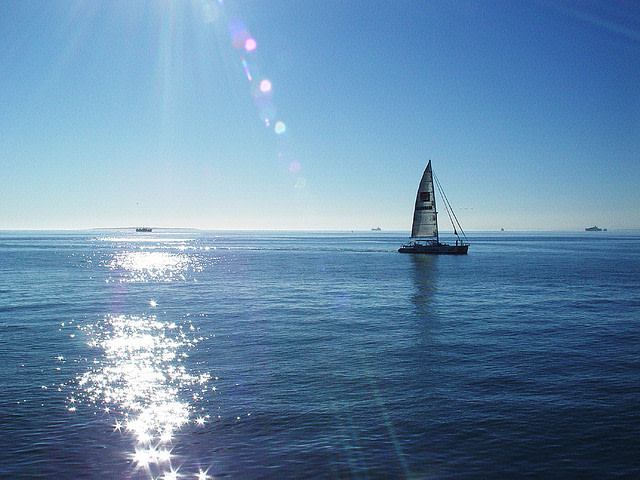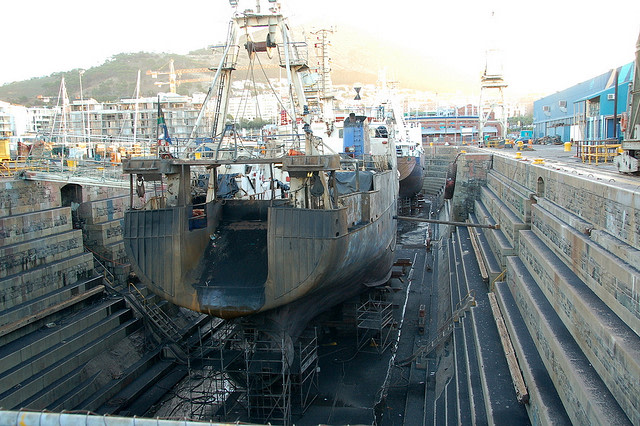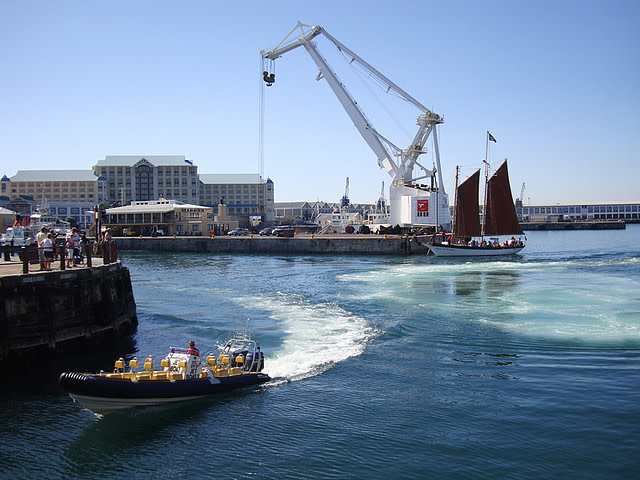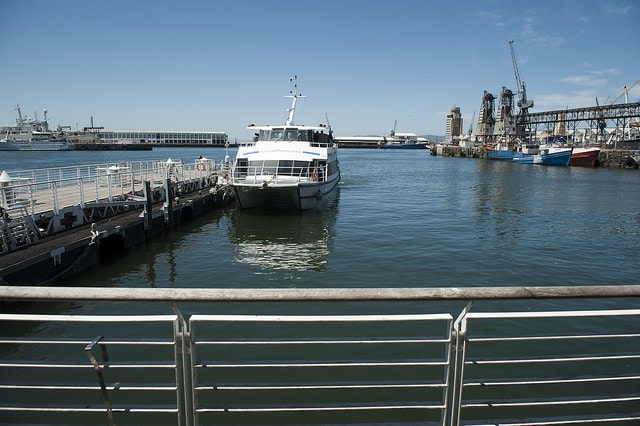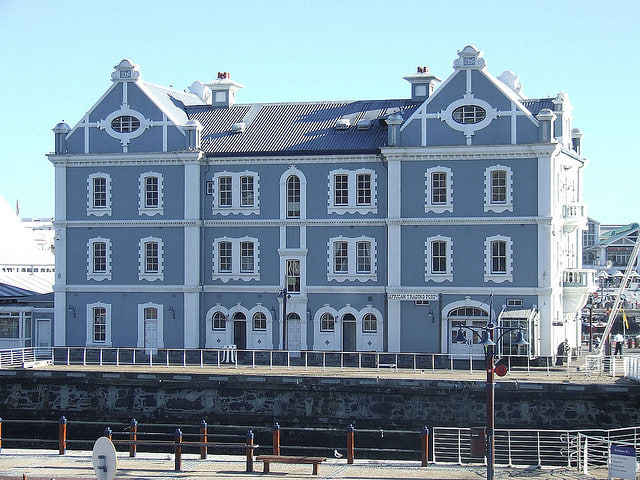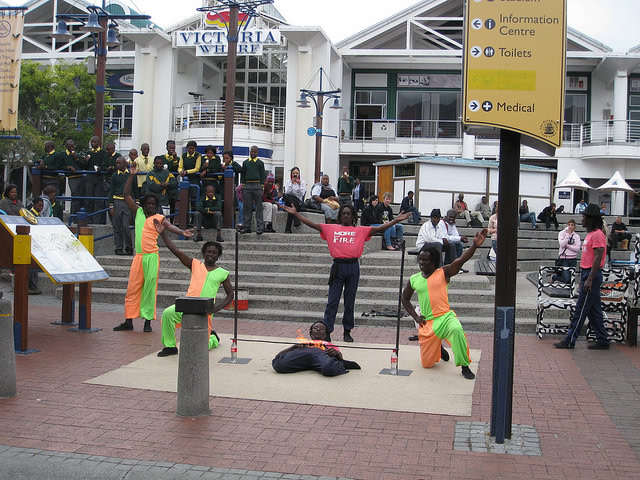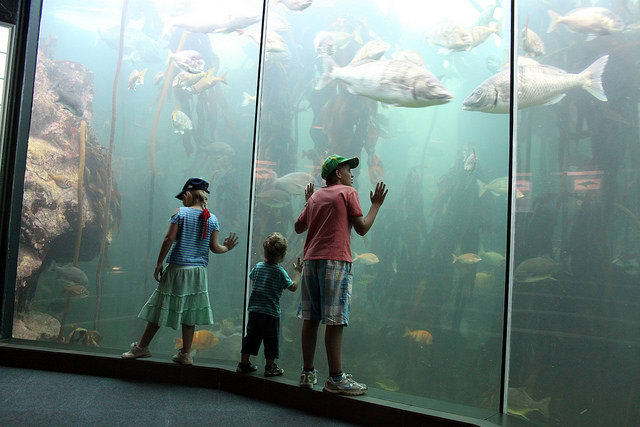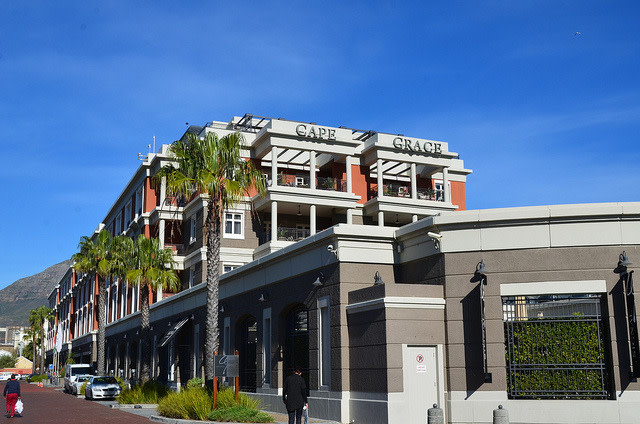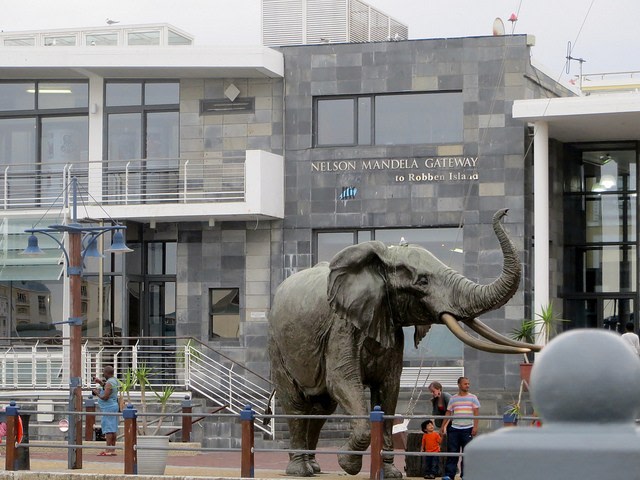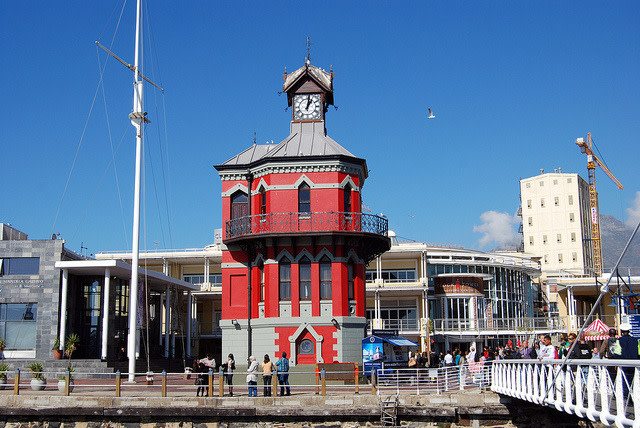
Table Bay, or Saldanha Bay as it was mistakenly originally called, is not a natural harbour and the North and North West winds experienced during the Cape Winter months caused untold numbers of shipwrecks in the bay. The bay is treacherous in the Winter months and partially protected in the Summer months from the South East gales which occur.
When Jan van Riebeeck established the refreshment station and settlement in 1652 he built a small jetty in the bay which remained in use for nearly two centuries.
The city situated on the shores of Table Bay, Latitude 33 degrees 56 minutes South and Longitude 18 degrees 28 minutes East, is named Cape Town.
During the Dutch period of control only two defensive batteries were constructed along the coastline, the Chavonnes and Amsterdam Batteries, and besides the jetty no harbour developments took place.
Use of Table Bay as an anchorage sustained very little development until 1860, when the British, who were then administering the Cape as a Colony of the British Empire under Queen Victoria, decided to establish a harbour in Table Bay.
After a very serious run of Winter storms in 1858, which wrecked more than 30 ships anchored in the bay, a decision was made to construct a harbour to provide proper and protected berthing facilities for ships calling at Cape Town.
Plans were drawn up by Mr. James Randall consisting of north and south breakwaters with respective lengths of 1300 meters and 1400 meters. This scheme was not accepted due to the fact that no wharfage would be provided, but only anchorage.
Mr. John Coode, an experienced harbour construction engineer, was appointed to draw up and submit alternative plans for a harbour.
The alternative plan from John Coode was to build a harbour basin comprising of a dry dock, breakwater, a patent slipway and some 4300 metres of wharf space, close to the site of the Chavonnes Battery.
In 1859 the British Government at the recommendation of Sir George Gray, the incumbent Governor of the Cape, approved the plans as drawn up by John Coode.
On 17 September 1860 Midshipman HRH Prince Alfred, who was 15 years of age, tipped the first load of stone to commence construction of the breakwater. This was also the first British Royal visit to the Cape and almost the entire population turned out to witness the occasion and take part in the celebrations.
Political convict and convicted illicit diamond buying labour was used for the construction of the breakwater and housing for these unfortunate persons was built at the Breakwater Prison.
During this 10 year period of construction work was started on the Robinson Dry Dock, which is still in use today, and Patent Slipway, today situated at the entrance to the road leading to the Nelson Mandela Gateway Complex.
The Alfred Basin was completed in 1870 and opened by Prince Alfred, who by now held the title of Duke of Edinburgh. Due to the discovery of gold on the Witwatersrand in 1886, and diamonds at Hopetown, and the opening of the Kimberley diamond mines in 1867, as well as the introduction of large steam driven vessels, the Alfred Basin almost immediately become too small for its purpose.
It took some 10 years of overcrowding in the harbour before John Coode was once again appointed to plan a larger harbour and construction of the Victoria Basin commenced in 1886 and was completed in 1895 adding 1500 metres of wharf space and extensive areas of cargo storage space.
The new basin once again soon became too small and in 1937 the construction of the Duncan Dock commenced on reclaimed land some distance from the then city centre.
This new harbour was finally completed in 1945.
Due to the land being reclaimed the Victoria and Alfred Basins were cut off from the city and almost totally fell into disuse as a shipping harbour and the fishing and small boat repair industry became its main lifelines. This caused the once pristine and main gateway to South Africa and its hinterland, to become a derelict and run down area.
Besides the small boat (line fishermen), the grain terminal, the harbour became home to the large deep sea trawlers, a fishmeal processing factory, an ice producing facility (still in use today) and a world renowned fish restaurant. Harbour tugs, pilot boats were the main users of the port facilities. Use was made of the Robinson Dry Dock and the Patent Slipway by fishing boats only. During the years of the use of Robben Island as a penal colony the ferry boats, carrying prisoners, victuals staff and visitors used the Quay 5 facilities as an embarktion point.
Land behind the Alfred Basin toward the mountain was used as an oil storage farm and only those seeking to reminisce about the past visited these two magnificent harbours and the surrounds.
By now, due to customs and security requirements, the Duncan Dock area had become completely in accessible to the public.
In 1985 the Mayor of Cape Town decided to try and uplift the badly run down old harbour area and by so doing re-establish our links with the sea and our past heritage.
A committee was established in1987, chaired by Mr.. Arie Burggraaf, to investigate and report on proposals for the redevelopment of the land occupied by the old harbours.
The committee put forward a proposal that the historic buildings around the Victoria and Alfred Basins be refurbished and converted into retail, commercial, tourist and residential components, while still retaining the working ambience of the two harbours, with the berths for the harbour tugs, the fishing boats and the two dry dock facilities.
This was accepted by the land owners, the South African Railways and Harbours, now renamed Transnet, and a holding company “The Victoria and Alfred Waterfront (Pty) Ltd.” was formed.
A retired Town Planner Mr. David Jack was appointed to oversee the re-vitalisation of the two harbours.
The ultimate intention was to utilise all of the land comprising of the two Basins, however an immediate start was made in converting the Pierhead area into a tourist attraction.
The Pierhead area had become very run down, however with its old world ambience of the original Port Captains Office, the old Docks Post Office, the first electric generating station, together with timber wharves and jetties and granite quay walls created a wonderful nostalgic feeling to those who visited the area.
In 1989 work commenced on the refurbishment of this area and by the end of 1990 the area was opened to the public as a tourist attraction. The Port Captains office, a magnificent double story building with old world architecture was refurbished and is still in use today as the Headquarters of the V & A Waterfront Company.
Across the harbour entrance, linked by the “Penny Ferry”, a relic from the days when seafarers used the small rowed ferryboat as a means to get to the Clocktower to relax, a restaurant was established and the site of the previously mentioned seafood restaurant was rebuilt into a now world renowned upmarket restaurant.
The restaurant across the harbour mouth became a “watering hole” to the younger population and the seal population were catered for with a small protected jetty to enable them to relax in the sun as well as being safe from injury by overzealous viewers from the restaurant.
Work was commenced on the construction of the “ Victoria Wharf” retail and shopping centre, designed by one of Cape Town’s foremost architectural partnerships – The Louis Karol Group--, with its selection of very upmarket boutique and speciality shops, cinema’s, chain store retail outlets and home to the Table Bay Hotel.
As further drawcards to bring the public to this new area an open air amphithetre was built where various performing artists, symphony concerts and other entertainment is held.
There are two dedicated areas used as craft markets where home industry can show and sell its wares to the public, numerous open air restaurants and an area where “buskers”, mime artists and solo entertainers can perform.
Two further extensions were carried out to the “Victoria Wharf” shopping complex making this one of the largest varied use shopping complexes in the world today. It is estimated that upwards of 60 000 people visit this V&A waterfront complex each day during the main tourist season in December/January.
Helicopter landing facilities form a part of the facilities and businessmen use this to go the out of town meetings and tourist flights around the Peninsula are available.
Many of the older derelict wharehouses were totally gutted internally and converted into, amongst others North Quay Wharehouse- The Victoria & Alfred Hotel, The old Harbour Café - Quay Four Restaurant, The Old Pump Station adjacent the Robinson Dry Dock - The Maritime Museum, Shop 17 where the dockyard cranes were overhauled - C D Where House and Two Oceans Aquarium.
At a site adjacent to the cassion which is use to seal off the Robinson Dry Dock is a tribute to the four South Africans who are recipients of the Nobel Peace Prize Award.
Half life size statues of Messrs. Nelson Mandela, F.W de Klerk, Arch Bishop Tutu and Albert Luthuli are on display. South Africa has the most citizens to have received recognition by receiving this award.
Across the present road and facing the new aquarium site are buildings which are of historical significance to the Victoria & Alfred complex. These comprise the Harbour Engineers Residence with the Time Ball Tower adjacent the house, The Breakwater Prison--- today home to the U C T Graduate School of Business as well as the Breakwater Lodge Hotel, the Dragon Tree the sap of which was in past years used to treat dysentery and diarrhoea.
The tank farm, which had fallen into disuse and become an eyesore, was dismantled and partially excavated to form a new yacht marina. The boat entrance to this marina is from the Alfred basin at the site where the coal fired steamships and latterly the coal fired trawlers were bunkered. The entrance has an access drawbridge which is opened to allow boat access to the marina. This marina also hosts the contestants in the annual round the world yacht race. It is a “halfway house” and replenishment station, as was in 1652 to the entrepid traders, to these yachtsmen.
The former West Quay, was used prior to the refurbishment as an off loading wharf and fish sorting area. The original “fish train” which carried fresh fish packed in crushed ice used to leave this wharf each night at midnight and deliver the fish to Johannesberg within 24 hours.
This wharf is now home to the world esteemed Cape Grace Hotel. This hotel, voted as being one of the five best hotels in the world, overlooks both the working harbour and the new marina. Visiting world statesmen live at this hotel when visiting Cape Town as its “island situation’ is ideal for security purposes.
Overlooking the new marina are recently completed blocks of luxurious apartments, the Two Oceans Aquarium and the site of the proposed seven star hotel complex being erected by Mr. Sol Kerzner.
Looking along the old harbour from the West Quay the working small boat fishing harbour, the patent slipway with its hive of wooden boat repair activity can be seen. The larger deep-sea trawlers today utilise the wharfs of the Victoria Basin to off load and sort their catches. Dry dock repairs to these large fishing vessels is still carried out in the original Robinson Dry Dock off the Alfred Basin.
A recent addition to the harbour has been the Nelson Mandela Gateway of which the historic “Clock Tower” forms part. Accessed from the City side of the V&A precinct and connected to the main V&A complex by a modern drawbridge, this Gateway area is now home to a large modern office block, formerly the B O E Headquarters, built on the site of a previous fishmeal factory and the Nelson Mandela Gateway which is the present day embarkation point for those travelling across the bay to the Robben Island museum and penal colony. The building is erected on the site of the former restaurant and fish market, with the only remain vestage of yesteryear being the landing platform for the seals.
During excavation of the site of the former fish meal factory, a large amount of military hardware dating back over nearly 250 years was recovered and was of significant interest to military historians.
From the windows of the Information Centre at the Nelson Mandela Gateway building the last remains of the once flourishing grain conveyor belts can be seen and the towers of the grain elevators (now disused) stand in forlorn outline against the Cape Town city skyline.
In 2006 the owners of the V&A Waterfront decided that, as its core business was that of transport and not one of property ownership and administration, to dispose of this asset and after negotiation the entire complex was sold to a Malaysian consortium of businessmen for the reported sum of R15 billion rand.
This consortium has made public its intention to invest at least double this amount into further developments such as boating marinas, hotels, office blocks and facilities for the subsistence fishermen presently utilising the small craft launching ramp in Granger Bay.
ACKNOWLEDGEMENT
Victoria & Alfred Waterfront Mr. P S van Zyl
Victoria & Alfred Waterfront Historical Profile
Encyclopedia Britannica 1911 Cape Town Harbour
History and Heritage of Coastal Engineering Nicholas C. Kraus
Livingstone Tourism Academy The Alfred and Victoria Basin
Malcolm Lee whose love of the harbour and its precints extends from early school days.
Image Details and Licenses: https://flic.kr/p/B67ad (Damien du Toit, CC BY 2.0), https://flic.kr/p/CBx36 (Robert Wallace, CC BY-NC-ND 2.0), https://flic.kr/p/6dXZXH (mikkelz, CC BY-NC-SA 2.0), https://flic.kr/p/jSqrjP (hubertus von welck, CC BY-NC-ND 2.0), https://flic.kr/p/5zLKBR (Robert Cutts, CC BY 2.0), https://flic.kr/p/8YeU9D (khym54, CC BY-NC-ND 2.0), https://flic.kr/p/nn5LPW (flowcomm, CC BY 2.0), https://flic.kr/p/f7tZhA (Richard Mortel, CC BY-NC-SA 2.0), https://flic.kr/p/edMx8j (bigskyred, CC BY-NC 2.0), https://flic.kr/p/cdQdHA (Harvey Barrison, CC BY-SA 2.0)


